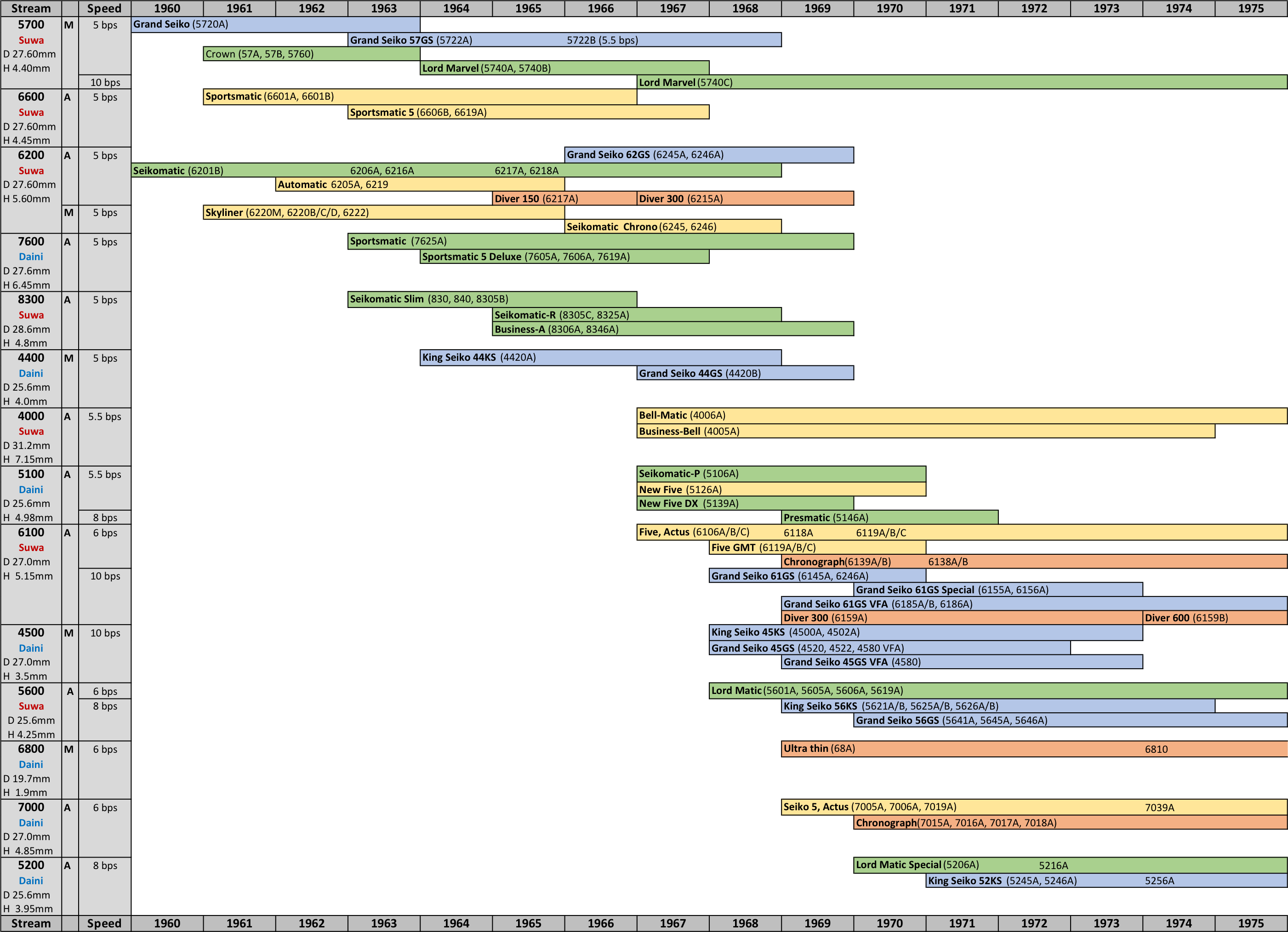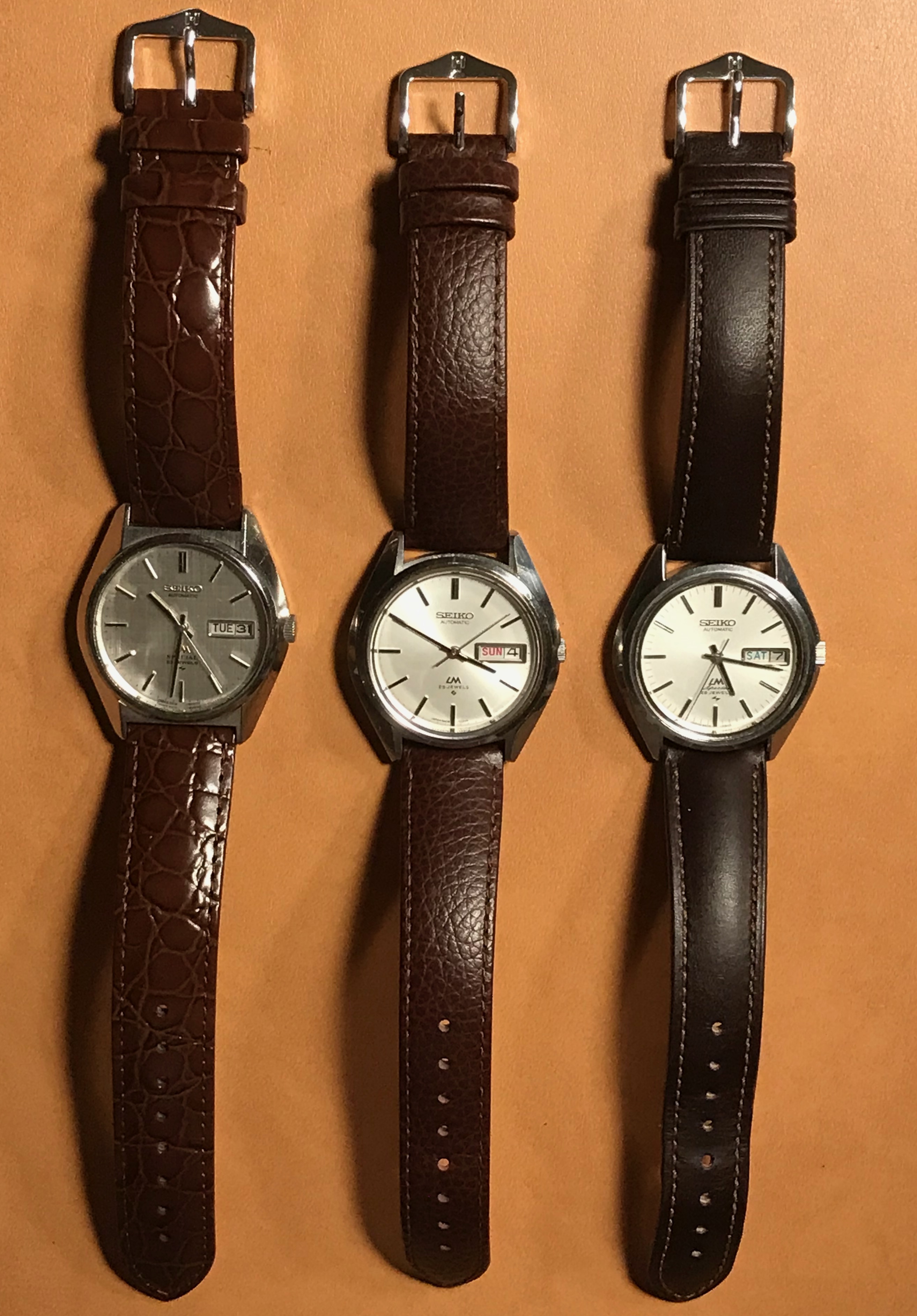Vintage Seiko watches attracted my attention for two reasons: Seiko advertisements for Grand-Seiko watches, which referred to their heritage, and the fact that the 4S15 movement was a re-release of the 52 movement stream from the seventies. We must first define what vintage actually means. Vintage is often used to differentiate products before the period of automated industrial production (usually before 1970). For Seiko watches I would change this to watches before 1975, so before the Quartz domination. It is of course true that Seiko also underwent a transition from a manufacture production to a more automated industrial production at the end of the sixties, but it is nevertheless sensible to draw the line at the definitive end of the era of mechanical watches in the seventies. Once you turn your attention to Seiko vintage watches, you will soon notice that there is a lot to learn and discover about these watches. At the beginning of the sixties, Seiko entered the western market and dared to challenge the established Swiss watch industry in terms of technology and quality. The series that comes to mind in this context is of course Grand Seiko.
When I first saw a classic Grand Seiko watch, I thought: What an ugly stainless steel watch, and that costs so much money. Grand Seiko is a Japanese product at its best: technology and quality at the highest level, but with a discreet, almost minimalist appearance. It takes some time until you can appreciate the reduced and pure design language. This is a well thought out rule set that defines how a Seiko watch should look like: The Seiko “Grammar of Design”, introduced by the Japanese designer Taro Tanaka at the beginning of the sixties.
A Seiko LordMatic 5606-7191 from 1973 showcasing Tanakas Grammar of Design:

Seiko LordMatic 5606-7191
The first thing you realize that there is much more going on in this period than just Grand Seiko. To understand the plethora of models you need to know that there are two competing Seiko plants: Suwa Seikosha (located in Suwa, Nagano district), and Daini Seikosha (located in the Tokyo area). The famous Grand Seiko line was created by Suwa. In every sector from basic models, over mid-range to high-end there have always been models available from both factories based on their own movements. There are two phases: Before 1968 with movements that are still mainly assembled by hand, and after 1968 with new movements that are manufactured in a more automated fashion. In 1968/1969 there is some overlap between those two phases.
I created a timeline of all movements and model lines from the beginning of the sixties to the mid seventies.To understand this timeline it is necessary to introduce the Seiko movement terminology. Movements at this time are usually characterized by a four digit number followed by a single character (e.g. 5216A). The first two digits characterize the movement stream. The third digit is used to distinguish the grade of the movement. It is not always fully clear what exactly is different between those versions. Is a 5206 different in construction than, e.g., a 5246? The last digit characterizes the complications: 1 stands for no complications, 5 for date, and 6 for day date. Special applications in divers or chronographs have usually a 5, 7, or 9 as last digit. Finally the character at the end stands for the revision of a movement.
Some words about the frequency at which the movements run. This is characterized how fast the balance wheel rotates. Watch makers specify this in half swings as beats per seconds (bps) or more commonly as vibration or beats per hour (bph). The physical correct unit for frequency is Hertz (Hz) which is one full swing per second. At the beginning of the sixties movements ran with 5bps which translates to 18000bph or 2.5Hz. One path of innovation was to increase the frequency of the balance wheel. This ended in the frantically fast high beat models running at 10bps or 36000bph. This was decreased again in the seventies to a more sane 8bps (28800bph), finding the balance between accuracy, power reserve, and wear. Seiko still called those 8bps movements high beat in contrast to the standard movements running with 6bps. Most contemporary Seiko movements run with 6bps. I will consistently use the bps metric to specify the speed of a movement.
The following illustration shows a timeline for all movements in this era
(click for larger image). High-end model lines are colored blue, mid-range
green and entry-level yellow. Special model lines as, e.g., chronographs are
colored red. The M in the second column stands for manual wound and the A for
automatic.

Seiko movement timeline
This timeline was created based on information on the web as well as vintage Seiko catalogs and manuals. We start chronologically in the year 1960 with the 5700 stream engineered by the Suwa factory, as all early movement streams. Used in the Grand Seiko model as 5720A this manual wound movement ran with a modest 5bps and was manufactured till 1963. In 1963 the 57GS was introduced using movement revisions 5722A and 5722B. The Grand Seiko 57GS was offered until the late sixties. Typical for Seiko the 5700 stream was used across multiple model lines: Crown from 1961 to 1963, and Lord Marvel from 1964 to 1975 (movements 5740A, 5740B,a and 5740C). The 5700 stream got famous in 1967 as the first movement implementing a 10bps high beat in the Lord Marvel 36000 (5740C movement). This high-beat Lord Marvel was offered till 1975 and makes this stream the longest running Seiko movement in this time period.
Also in 1960 the Seiko workhorse stream was introduced, the Suwa 6200 stream. This is the first automatic Seiko movement and also runs with 5bps. For entry level lines also a manual wound version was available. Initially in the mid-range Seikomatic line, followed in 1961 as manual version in the entry-level Skyliner line and in 1962 in the Automatic line. This movement was used in the iconic diver models Diver 150 (1965-1966) and Diver 300 (1967-1969). In 1966 a high end variant (6245 and 6246) was introduced as Grand Seiko 62GS, the first automatic Grand Seiko.
In 1963 Daini released its first movement, the automatic 5bps 7600 stream which was until the end of the sixties in the Sportsmatic and Sportsmatic 5 deluxe model lines. Also in 1963 Suwa introduced the especially slim 8300 stream targeted at upper mid-range models: Seikomatic slim, Seikomatic-R, and Business-A. 1964 follows the Daini high-end 5bps manual 4400 stream, initially offered as 4420A in the King Seiko 44KS and later in 1967 as 4420B in the iconic Grand Seiko 44GS. Daini in 1967 countered the slim Suwa made 8300 stream with its 5.5 bps 5100 stream used in Seikomatik-P and New-Five/New-Five DXmodel lines and later as 8bps high beat variant in the Presmatic models. The 5100 stream was offered until 1971. This successful decade ended with the introduction of the alarm wristwatch movement stream 4000 offered from 1967 until 1975 in the Bellmatic and Business-Bell model lines.
The beginning of the seventies marks the shift from manufacture production to a more automated industrial production. And three movements are characteristic for this shift: the Suwa 5600 stream, and the Daini 5200 and 7000 streams. But first lets have a look at two movement streams that still have their roots in the previous decade: the Suwa made 6100 stream and the Daini 4500 stream. The Suwa 6100 stream is taking the role of its predecessor 6200 stream as a workhorse movement used in all model line levels from entry-level Five models to high end Grand Seiko and Diver models, as well as in the Chronographs with 6138 and 6139 movements. The movement was available in a low beat 6bps variant for the entry-level models and a high beat 10bps variant for high end applications and offered till 1975. The Daini 4500 stream is the high beat successor to the 4400 stream, and was exclusively used in hand wound high end models of the King Seiko and Grand Seiko lines and available from 1968 to 1973.
From left to right: A 5216-8020 from 1975, a 5606-7191 from 1973, and a 5206-6130 from 1972:

Seiko Lord Matic watches
The model lines for the mechanical watches were consolidated with Seiko 5 and Actus being the entry level model lines, and Seikomatic being replaced in the mid-range by the new Lord Matic line. The high end stayed the same with Grand Seiko at the top and King Seiko one notch behind. Suwa used its 5600 stream initially in the new Lord Matic line (1968, with 6bps), its King Seiko 56KS models (1969, 8bps), and finally in the Grand Seiko 56GS models (1970, 8bps). All models were available until at least 1975. Many argue that the Suwa factory lost its leadership in technology and innovation during the sixties to the rival Daini competitor. Still there are experts that regard the 5600 stream as the epitome of Seiko mechanical movements. Unfortunately the 5600 movement has one design or lets better call it material flaw: the day/date quick set mechanism. It is in parts made of plastic that is fragile and subject to aging and is broken in a lot (some say most) of used watches with this movement from this time. I have only a small selection of 5600 based watches, and in two thirds the day and/or date quick set is broken.
What had the Daini factory to offer? In the entry level (remember Suwa uses its 6100 stream there) they offered their new 7000 stream, that was optimized for cost and low maintenance, for applications in the Seiko 5 and Actus model lines. This movement was also used in a series of iconic chronograph models. What is the 5600 stream for Suwa, a thin, modern automated mechanical movement, is the 5200 stream for Daini. Introduced in 1970 in the Lord Matic Special models (5206A), and in contrast to the mid-range Suwa models also running with a 6bps high beat. In 1971 the King Seiko 52KS followed using the 5245A and 5246A movements. Production of watches with a 5200 stream movement continued into 1976. The 5200 stream was the basis for the 4S high end movement introduced in 1992.
One last missing movement is the Daini 6800 movement stream introduced in 1969 and still in production. This is a special purpose hand-wound movement tailor made for extremely thin watch models. It has a diameter of only 19.7mm and a thickness of incredible 1.9mm. I hope this rough but complete overview gives a good impression about the variety in movements released by Seiko in the golden ages of mechanical watches. There is a lot more to tell about the history and technology of the different model lines. But this is the topic of future posts.
Links:
More information on vintage Seiko watches:
- Watch Wiki category page for Seiko watch calibres.
- Watch Wiki overview article for Seiko watches.
- Adventures in Amateur Watch Fettling Blog with tons of information, images, and technical details about mostly vintage Seiko watches.
- The Grand Seiko Guy Offering vintage watches. But also has many articles on Seiko history as well as reference material.
- Plus9Time Website of an enthusiast watch collector with articles on background story, history, and reference material.
- Article in Worn and Around Magazine about Taro Tanaka and his Grammar of Design
- Article in Worn and Around Magazine about the rivalry of the two Seiko factories Suwa and Daini.
- Article on monards website about Grammar of Design principles.